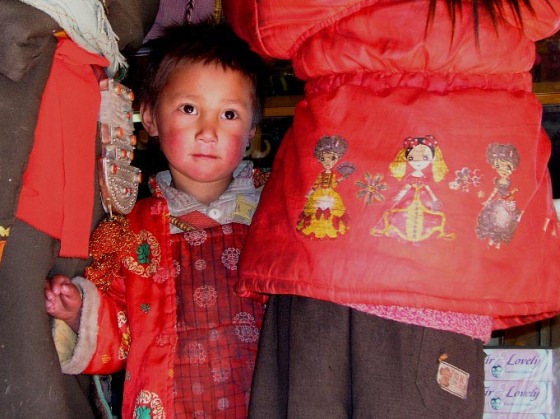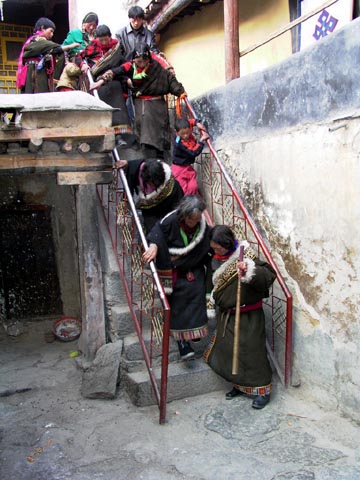Ramoche Monastery - Lhasa
 03.30.2008
03.30.2008 
Greetings,
The following piece was written during a visit to Lhasa in 2005 while teaching in Sichuan. The Ramoche monastery was a special place for me to sit down and practice.
Ramoche was the starting point, the beginning of a peaceful march by monks on March 10th which began the current international Tibetan demonstrations and cries for freedom.
+
A Tibetan woman in her rainbow apron and thick heavy yak felt boots shuffles along, pausing to make sacred prayers. Her deep lined brown hands join, rise in a blessing over her head, descend to her forehead down to her heart before prostrating herself out, stretching full length along stones on hands and knees, touching her forehead to the ground with her arms extended out in front of her. She unfolds from the ground, rising softly and walks forward, performing her ritual repeatedly. Earning merit. Offerings.
Side streets offer tables of huge yellow cakes of butter, slabs of meat as laughing Khampa men hack through bone, weighing it up on old scales. Piles of yak heads, glistening butter. Muslim merchants in skull caps and white beards from Xinjing push rolling carts of dried fruit - apricots, raisins, dates.
I wander near the Barkhor down narrow twisted alleys - severed tree branches with prayer flags stapled to their thin arms stand against a house. The trees have been cut into long slender segments. Before New Year, or Losar, people will buy them, climb onto their roofs and replace the old ones on four corners.
A man inks prayer flags. He sits in partial sun with rolls of white, red, blue, yellow, green cotton cloth to his left. On a pillow are two 8×10" carved wooden blocks. Black ink from a plastic bottle floats in a small pan. He sponges up what he needs and coats a block. He pulls white cloth over it, centers a segment, slides his hand into a torn plastic bag, starts at the bottom and applies pressure up, down, sideways. Ink bleeds through. He pulls cloth through, re-inks the block, repeating the procedure. A man next to him cuts dried cloth into individual pieces and staples colors to thin branches.
I took a side street to Ramoche built in 641 by Wenchang, a Chinese princess. Her Tibetan name was Kongjo.
Peaceful, quiet, - many pilgrims, kids, elderly spinning long rows of prayer wheels. Inside beautiful statues, past, present and future Buddhas, dancing in flickering butter lamps. Many people buy yellow bags of butter to spoon into large ornate butter candles as they proceed around and through the temples.
A monk invites me to sit on a carpet inside a small interior chapel in late afternoon, contemplating large tall, beautifully sculpted and decorated statues. Amazing art and meditative peace.
On the far ochre wall is a mural painting of multiple yellow Buddhas, with a patina aureole halo around his smiling head and face. Suddenly I see one image is half illuminated by a single shaft of bright light from the sun slanting through an opening way near the ceiling. Beautiful and immediate!
I just sat there absorbing this vision as light examined the face, slowly moving across it from left to right.
An old man with a serene dirty face entered with a toddler. The child immediately went to the statue on the left, touched his forehead on the fabric at the base, backed up, put his hands together at his head, mumbled his prayer and moved to the larger center statue. He repeated his ritual.
He forgot to put his hands together so his grandfather whispered a couple of words and the boy made his prayer. He skipped off to the third statue as the old man followed him.
Families, parents, old single men and women, young singles, and couples shuffled through in an endless procession.
I went outside, past people doing their prostrations to sit in the sun with a group of monks. One smiled, “You didn’t pay the entrance fee.”
“Oh, I’m sorry. I didn’t know there was one.”
“Yes,” he said, pointing to a half hidden fading sign on a slab of door, reading “Office. 20Y.”
“Would you like me to pay now?”
“No, it’s ok,” he smiled.
He asked the standard questions. “Where are you from? How long have you been here?”
“I am from everywhere. I’ve been here all day.”
“How long have you been here?” I asked.
“Seven years. It’s ok,” adding, “Buddhism is about compassion.”
“Yes it is.”
Ramoche is a fine place and I will return often.
Peace.







Reader Comments